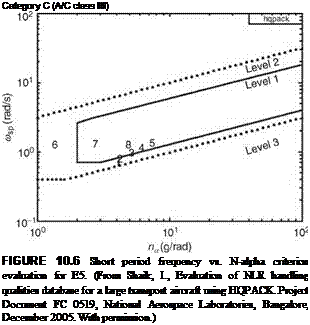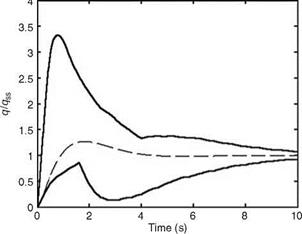Rotorcraft Handling Qualities
Boeing/Sikorsky RAH-66 Comanche military helicopters are designed to meet the HQ specifications of ADS-33D [29]. ADS-33D (aeronautical design standards)
|
TABLE 10.9 Comparison of Handling Qualities Evaluation Results for a Large Transport Aircraft (E5)
Source: Shaik, I. Evaluation of NLR handling qualities database for a large transport aircraft using HQPACK. Project Document FC 0519, National Aerospace Laboratories, Bangalore, December 2005. |
 |
|
sp
 |
FIGURE 10.5 CAP criterion evaluation for E5. (From Shaik, I., Evaluation of NLR handling qualities database for a large transport aircraft using HQPACK. Project Document FC 0519, National Aerospace Laboratories, Bangalore, December 2005. With permission.)
|
Large supersonic aircraft criterion (FC E-5)
FIGURE 10.7 Pitch rate time-history criterion evaluation for E5. (From Shaik, I., Evaluation of NLR handling qualities database for a large transport aircraft using HQPACK. Project Document FC 0519, National Aerospace Laboratories, Bangalore, December 2005. With permission.) |
contains the requirements for the flying and ground HQs for rotorcraft [30]. These requirements should be complied with, by the process of analysis, simulation, and flight tests at various stages of the design and development of a helicopter. Some of these are the following: (1) Prior to the critical design review—analytical checks should be computed/made using the available math models; (2) Prior to the first flight—analytical checks should be made using full nonlinear math models, which include the feel system and SCAS elements. Also, the assessment should be done in flight simulators by the test pilots; (3) After the first flight, except for maneuvers that are hazardous or impractical, the flight test verification of all maneuvers should be carried out. ADS-33D defines the flying qualities in terms of Levels 1, 2, and 3 as well as UCE (usable cue environment) of 1, 2, and 3. UCE depends on the assessment of the displays and vision aids that are provided to the pilot. The UCE level is determined from VCR (visual cue rating) scale for at least three pilots. The ADS-33D requirements are specified in terms of small-, medium-, and large- amplitude changes. In essence, the ADS-33D HQ assessment relies upon objective analysis.












